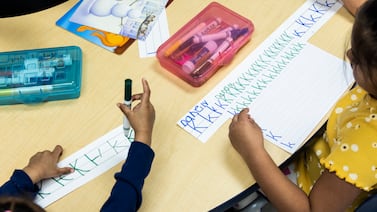Michigan has spent tens of millions of taxpayer dollars aimed at improving early literacy, yet roughly one in three Michigan fourth-graders don’t have basic reading skills, a figure that has hardly budged in two decades.
Sen. Jim Runestad says he can help explain why: In the 50 years since he was an elementary schooler with dyslexia grappling with a “mishmash of letters” in English class, little has changed for people like him.
Maeve Janssens, an 8-year-old from northern Michigan who was diagnosed with dyslexia this summer, knows the feeling of struggling to decode text on a page.
“It just didn’t click in my brain,” she said. “I felt like I couldn’t do anything.”
Dyslexia is a common and well-understood learning disability. As many as 15% to 20% of people have some of the symptoms of dyslexia, which make reading difficult. Studies show that most people with dyslexia who receive high-quality instruction early on will become average readers. More than two-thirds of states try to promptly identify children who struggle with the basics of decoding text and to teach them the skills they need to become literate.
Yet Michigan law barely mentions dyslexia.
“Michigan currently has no statewide strategy to screen and treat dyslexia, the most common language-based learning disability in existence,” Runestad, a Republican from southeast Michigan, wrote in October. “This is unacceptable.”
Runestad is part of a bipartisan group of lawmakers backing a package of bills designed to help students with dyslexia. Their proposals, expected to reach the Senate early next year, would identify students who show signs of dyslexia in the early grades, and give educators more training to identify and work with dyslexic students.
The bills still have a long way to go. Senate analysts haven’t yet said how much they are likely to cost, and school associations and universities could still withhold their support, hurting the bills’ political prospects.
Still, advocates believe the bills have a good chance at passage because they have the support of key senators from both parties. And they’ve won the support of some education leaders who say Michigan’s approach to literacy is outdated and disadvantages struggling readers.
“These proposed bills are the most promising K-12 reform-minded legislation I have seen since being superintendent in Detroit,” said Nikolai Vitti of the Detroit Public Schools Community District in a statement. Vitti has dyslexia himself and is raising children with dyslexia.
Decades of education research suggest that enacting the right early literacy policies together can make a huge difference for students with dyslexia and other struggling readers. Mississippi has garnered national attention for its focus on putting in place these pieces — high-quality literacy curriculum, well-trained teachers, and effective early screening and intervention for reading difficulties. After seeing little return on its investments to improve reading scores, Colorado recently shifted its focus to these policies as well.
“If you think about it, it’s a somewhat easy fix to give people a life,” said Nadine Gaab, an associate professor of pediatrics at Harvard Medical School who studies dyslexia and early literacy.
“We know that you are more likely to enter the criminal justice system if you’re a poor reader. It has tremendous implications for your self-esteem. There are higher rates of suicide. It’s estimated that 30% of inmates in the U.S. have a language-based learning disability. There are a lot of implications if you can’t read in this society, more than if you can’t do math.”
Advocates say the dyslexia bills will strengthen Michigan’s approach to literacy, but some education leaders aren’t yet convinced, and concerns about school funding could complicate the proposals’ political prospects.
Here are some of the key issues to watch as these proposals are debated in 2021:
What’s the problem, and what’s being proposed?
Dyslexic students can learn to read with the right kind of help. But Michigan is allowing some of them to fall through the cracks, said Brian Gutman, director of external relations at Education Trust-Midwest, a nonprofit education advocacy group.
“It’s startling that in Michigan in 2020 we still don’t have a system that makes sure that [dyslexic students] are identified as early as possible and teachers are equipped in classrooms across the state to meet the needs of a significant portion of the population,” he said.
Michigan already provides specialized services to many dyslexic students. Dyslexia is one of the most common learning disabilities recognized by the state.
However, fewer students with disabilities have been recognized in recent years, a trend some advocates say doesn’t reflect reality, but rather a narrowing of special education criteria in Michigan.
Supporters of the bills hope that by identifying dyslexic students early, they can help them become effective readers without resorting to the expensive and complex special education process.
“There are a number of kids who in the first and second grades, they get through really well because they have a lot of really good oral language,” said David Winters, one of the authors of the bills and the head of the department of special education and communications sciences and disorders at Eastern Michigan University.
The bills propose to solve this problem by requiring schools to screen all students in kindergarten through third grades for signs of dyslexia. Schools would only flag signs that a student might be dyslexic; it takes a trained clinician to provide a diagnosis. Supporters of the bills say that schools could flag possible dyslexic students using the same literacy screening tests that they already must give to young students under Michigan’s third-grade reading law.
Winters worries, too, that classroom teachers in Michigan aren’t getting enough instruction in the structure of language that students need to acquire to become good readers and writers.
Teachers in training “consistently say, ‘nobody taught us this, or nobody told us anything about this,’” he said. “It’s a knowledge issue, it’s not a motivation issue.”
The bills would attempt to improve literacy instruction by 2024, by requiring teacher preparation programs to offer instruction on dyslexia and how to support dyslexic students and by requiring teachers to have a minimum level of training about dyslexia to be certified.
What works for dyslexic students?
In short: Curriculum and instruction that attend to the sound components of language, given as early as possible in a students’ school career.
A key finding of research on struggling readers is that the sooner they get help, the better.
Numerous studies show that when struggling beginning readers receive intensive instruction, 56% to 92% become average readers. Researchers have also found that it’s easier to help struggling readers in kindergarten and first grade than later and that overall, struggling readers need help “early and often.”
Shannon Koenen, a member of the board of directors of the International Dyslexia Association-Michigan, said it took far too long for her son to be diagnosed as dyslexic. He didn’t learn to read until he was 10 years old.
“He was getting in trouble at school, and he was having all kinds of mental health problems,” she said. “If this bill had been in effect when my son was in kindergarten, not only would he have better skills, he would have avoided heartache.”
Quickly identifying students who may have dyslexia isn’t enough, however, if teachers don’t have the skills to help them.
“Anybody at the elementary level who is engaged in teaching literacy must really understand the typical characteristics of dyslexia, and especially how they can adjust their own teaching” to help dyslexic students, Winters said. That means focusing on the relationships between letters and sounds. For instance, a teacher might ask students to identify the sounds that make up the word “fix” (there are four, Winters said).
Curriculums that focus on the sound elements of language are also viewed as crucial for students with dyslexia. The bills require the Michigan Department of Education to provide schools with “instructional methods and curriculum resources” that work for students with dyslexia by the 2023-24 school year.
A ‘philosophical logjam’ over literacy instruction
Heather Eckner, a special education advocate in Ann Arbor and a former classroom teacher, said Michigan schools have drifted too far away from explicitly teaching phonemic awareness, or the ability to hear and manipulate the sounds in spoken words.
For evidence, she points to her own experience in teacher training.
“I was trained in this philosophy of letting kids find their own way” to reading rather than directly teaching them how written language works, she said. “I recently came across some papers from grad school, and I was horrified at what I wrote.”
Eckner and other supporters of the dyslexia proposals say they hope the bills will push schools to focus more on the structures of literacy.
“There’s been a philosophical logjam,” said Susan Schmidt, a retired Michigan teacher and advocate who helped draft the bills. “Reading instruction, around the time I got to college, took on the idea that reading is like speaking: We’ll just immerse you, and then you’ll figure it out.”
There is no research showing what the average Michigan teacher learns about literacy instruction before entering the classroom. Similarly, there is no data showing how much class time teachers typically spend on different types of reading instruction.
“There’s no empirical research,” said Elizabeth Moje, dean of the College of Education at the University of Michigan. “The claims [about how reading is taught in Michigan] are made without evidence, though that doesn’t mean that there isn’t a problem.”
Some teacher preparation programs in Michigan don’t give educators the skills they need to teach early readers, including students with dyslexia, Moje said, though she said her university does give future teachers those tools.
Paula Lancaster, dean of the college of education at Central Michigan University, said her program is already fulfilling the teacher training requirements laid out in the dyslexia bills.
”We recognize and teach the science of language and reading development,” she wrote in an email. “Thus, the content changes suggested in these bills align with our approach.”
Moje said she is not necessarily opposed to the bills, but she cautioned that they could push schools to overemphasize sound-based elements of literacy instruction — the parts that are especially important for dyslexic students — at the expense of other elements.
An overemphasis on phonemics — or the sounds of language — could be problematic for students who can easily link sounds and letters, but struggle in other ways.
“We absolutely need systematic instruction in phonemic awareness,” she said. “It’s necessary, but not sufficient.”
Moje also warned that elementary school teachers in training learn much more than literacy instruction, and that it is unrealistic to expect them to exit teacher colleges as experts in reading disabilities.
‘Unfunded mandate’ or cost-saver?
Runestad and Maeve both had the feeling of exclusion that is common among struggling readers.
“It was a feeling that you’re falling further behind, Runestad recalled. “You can’t figure out why but you’re slipping behind.”
Maeve, who has three older siblings, couldn’t help but compare her reading abilities to theirs. By second grade, her deteriorating self-esteem became apparent to her family, said her mother, Amy Janssens. “She came up with tricky strategies to avoid reading at school.”
“I would hide under the desk when we were doing reading groups and pretend I was doing something else,” Maeve said.
Still, both Runestad and Maeve were fortunate in at least one sense.
Runestad’s parents paid for him to attend a literacy summer camp, which helped him crack the code. Today, he reads constantly, though he has accepted that he’ll never be a speed reader. He’s currently working through a three-volume history of political oppression in the Soviet Union.
Maeve’s family paid for a literacy summer camp, too, and for a year of one-on-one lessons with a clinician who specializes in dyslexia. Reading still doesn’t come easily, but she can read, and her confidence is back.
“I can read bigger books. It’s easier now and I feel like I can do anything,” she said.
Amy Janssens said she and Maeve are advocating for the dyslexia bills because many families can’t afford to pay for private dyslexia testing and instruction.
“It’s not a viable solution for any family,” she said. “The amount of money that it takes to get a dyslexia diagnosis and the amount of money it takes to get real support isn’t accessible to pretty much anyone right now.”
Eckner, the special education advocate, said it’s common for families to pay lots of money to support their students with dyslexia if they have the means to do so.
“There’s a huge groundswell of parents who are paying thousands of dollars for outside instruction because their kids are not learning to read in school,” she said.
So will schools have to cover those costs if the bills are passed?
That question poses perhaps the most significant threat to the proposals’ chance of becoming law. The dyslexia bills don’t provide any new funds, for instance, to hire more reading specialists. New spending likely wouldn’t gain traction in the GOP-controlled state legislature in the midst of a recession.
“Districts are afraid of another unfunded mandate, which I believe will be the inevitable argument made by districts and their lobbyists when these bills move forward,” said Vitti, the Detroit superintendent.
Vitti said K-12 education badly needs more funding, but he believes that districts can better serve struggling readers even with the funding they already have. His district recently adopted an effective elementary English curriculum, and is in the process of training all of its teachers in the science of reading.
“There is no doubt that additional funding would assist districts and schools to implement these reading interventions but the truth is that they need to start using their funding differently for teacher training, materials, and interventions,” he added.
Still, school groups say they are not ready to sign on to the bills.
“As of now, we have some concerns with the details of the bills as drafted,” Peter Spadafore, spokesman for the Michigan Association of Superintendents and Administrators, said in a statement. He declined to specify the issues.
Gutman, the education advocate, said screening students for dyslexia using existing tests provides valuable information to teachers without adding additional costs.
“Whether these students are identified or not, the need is still there,” he said. “It frankly shouldn’t be controversial.”
Winters, the professor of special education, said the bills could save money.
“If we could do a good enough job catching more students than we are now who are struggling to read, then it should reduce the caseload in special education,” he said, “which means that you end up spending less money.”
Moje said one reliable way to get more students reading would be to hire more literacy experts. Michigan’s third-grade reading law, which was passed in 2016, helped hire teacher coaches across the state to focus on literacy instruction — but not enough to make much of a difference.
“I would say that we need to all be advocating for more literacy specialists who have the deep knowledge of literacy challenges,” she said. “We used to have many more.”
This story was produced with support from the Education Writers Association Reporting Fellowship program.




